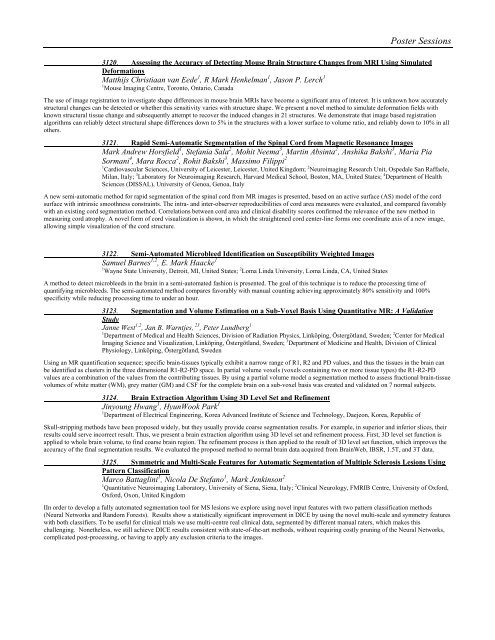TRADITIONAL POSTER - ismrm
TRADITIONAL POSTER - ismrm
TRADITIONAL POSTER - ismrm
Create successful ePaper yourself
Turn your PDF publications into a flip-book with our unique Google optimized e-Paper software.
Poster Sessions<br />
3120. Assessing the Accuracy of Detecting Mouse Brain Structure Changes from MRI Using Simulated<br />
Deformations<br />
Matthijs Christiaan van Eede 1 , R Mark Henkelman 1 , Jason P. Lerch 1<br />
1 Mouse Imaging Centre, Toronto, Ontario, Canada<br />
The use of image registration to investigate shape differences in mouse brain MRIs have become a significant area of interest. It is unknown how accurately<br />
structural changes can be detected or whether this sensitivity varies with structure shape. We present a novel method to simulate deformation fields with<br />
known structural tissue change and subsequently attempt to recover the induced changes in 21 structures. We demonstrate that image based registration<br />
algorithms can reliably detect structural shape differences down to 5% in the structures with a lower surface to volume ratio, and reliably down to 10% in all<br />
others.<br />
3121. Rapid Semi-Automatic Segmentation of the Spinal Cord from Magnetic Resonance Images<br />
Mark Andrew Horsfield 1 , Stefania Sala 2 , Mohit Neema 3 , Martin Absinta 2 , Anshika Bakshi 3 , Maria Pia<br />
Sormani 4 , Mara Rocca 2 , Rohit Bakshi 3 , Massimo Filippi 2<br />
1 Cardiovascular Sciences, University of Leicester, Leicester, United Kingdom; 2 Neuroimaging Research Unit, Ospedale San Raffaele,<br />
Milan, Italy; 3 Laboratory for Neuroimaging Research, Harvard Medical School, Boston, MA, United States; 4 Department of Health<br />
Sciences (DISSAL), University of Genoa, Genoa, Italy<br />
A new semi-automatic method for rapid segmentation of the spinal cord from MR images is presented, based on an active surface (AS) model of the cord<br />
surface with intrinsic smoothness constraints. The intra- and inter-observer reproducibilities of cord area measures were evaluated, and compared favorably<br />
with an existing cord segmentation method. Correlations between cord area and clinical disability scores confirmed the relevance of the new method in<br />
measuring cord atrophy. A novel form of cord visualization is shown, in which the straightened cord center-line forms one coordinate axis of a new image,<br />
allowing simple visualization of the cord structure.<br />
3122. Semi-Automated Microbleed Identification on Susceptibility Weighted Images<br />
Samuel Barnes 1,2 , E. Mark Haacke 1<br />
1 Wayne State University, Detroit, MI, United States; 2 Loma Linda University, Loma Linda, CA, United States<br />
A method to detect microbleeds in the brain in a semi-automated fashion is presented. The goal of this technique is to reduce the processing time of<br />
quantifying microbleeds. The semi-automated method compares favorably with manual counting achieving approximately 80% sensitivity and 100%<br />
specificity while reducing processing time to under an hour.<br />
3123. Segmentation and Volume Estimation on a Sub-Voxel Basis Using Quantitative MR: A Validation<br />
Study<br />
Janne West 1,2 , Jan B. Warntjes, 23 , Peter Lundberg 1<br />
1 Department of Medical and Health Sciences, Division of Radiation Physics, Linköping, Östergötland, Sweden; 2 Center for Medical<br />
Imaging Science and Visualization, Linköping, Östergötland, Sweden; 3 Department of Medicine and Health, Division of Clinical<br />
Physiology, Linköping, Östergötland, Sweden<br />
Using an MR quantification sequence; specific brain-tissues typically exhibit a narrow range of R1, R2 and PD values, and thus the tissues in the brain can<br />
be identified as clusters in the three dimensional R1-R2-PD space. In partial volume voxels (voxels containing two or more tissue types) the R1-R2-PD<br />
values are a combination of the values from the contributing tissues. By using a partial volume model a segmentation method to assess fractional brain-tissue<br />
volumes of white matter (WM), grey matter (GM) and CSF for the complete brain on a sub-voxel basis was created and validated on 7 normal subjects.<br />
3124. Brain Extraction Algorithm Using 3D Level Set and Refinement<br />
Jinyoung Hwang 1 , HyunWook Park 1<br />
1 Department of Electrical Engineering, Korea Advanced Institute of Science and Technology, Daejeon, Korea, Republic of<br />
Skull-stripping methods have been proposed widely, but they usually provide coarse segmentation results. For example, in superior and inferior slices, their<br />
results could serve incorrect result. Thus, we present a brain extraction algorithm using 3D level set and refinement process. First, 3D level set function is<br />
applied to whole brain volume, to find coarse brain region. The refinement process is then applied to the result of 3D level set function, which improves the<br />
accuracy of the final segmentation results. We evaluated the proposed method to normal brain data acquired from BrainWeb, IBSR, 1.5T, and 3T data.<br />
3125. Symmetric and Multi-Scale Features for Automatic Segmentation of Multiple Sclerosis Lesions Using<br />
Pattern Classification<br />
Marco Battaglini 1 , Nicola De Stefano 1 , Mark Jenkinson 2<br />
1 Quantitative Neuroimaging Laboratory, University of Siena, Siena, Italy; 2 Clinical Neurology, FMRIB Centre, University of Oxford,<br />
Oxford, Oxon, United Kingdom<br />
IIn order to develop a fully automated segmentation tool for MS lesions we explore using novel input features with two pattern classification methods<br />
(Neural Networks and Random Forests). Results show a statistically significant improvement in DICE by using the novel multi-scale and symmetry features<br />
with both classifiers. To be useful for clinical trials we use multi-centre real clinical data, segmented by different manual raters, which makes this<br />
challenging. Nonetheless, we still achieve DICE results consistent with state-of-the-art methods, without requiring costly pruning of the Neural Networks,<br />
complicated post-processing, or having to apply any exclusion criteria to the images.















